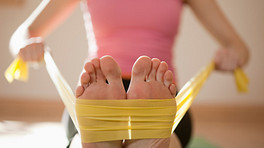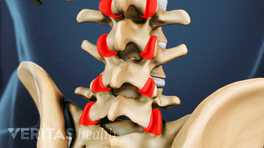Back pain from osteoarthritis can make a person feel helpless, but several steps can be taken at home to ease pain and improve spine function.
While self-care and exercise are considered safe for most people with spinal osteoarthritis, it is a good idea to consult with a doctor or physical therapist first. A health professional can consider a patient’s unique circumstances and provide advice about which home treatments will be the most safe and potentially beneficial.
In This Article:
Periodic rest
A little discomfort is to be expected as stiff joints loosen up in the morning or at the beginning of exercise. However, moderate to serious back pain is a signal that the spine, surrounding muscles, and other soft tissue need a rest.
For example, people with low back pain may benefit from curling up on a firm mattress for a couple of hours (the fetal position takes pressure off the facet joints). When pain is extreme, a person may require 1 to 2 days of rest.
Warm or cold compress
Using a warming pad or whirlpool for a few minutes can loosen a stiff back and make activity easier. Icing the back for 15 or 20 minutes after activity can decrease swelling and provide quick pain relief.
See Applying Heat vs. Cold to an Arthritic Joint
These temporary treatments will not alleviate the underlying causes of back pain or improve long-term joint function.
Weight loss
Extra pounds put extra pressure on the spine’s facet joints. People who are obese are 5 times more likely to have osteoarthritis in the lumbar spine. A diet to maintain a healthy weight can pay big dividends for those suffering from osteoarthritis of the spine, particularly osteoarthritis of the lumbar spine. 1 Suri, P, Katz JN, Rainville J, Kalichman L, Guermazi A, Hunter DJ. Vascular disease is associated with facet joint osteoarthritis. Osteoarthritis and cartilage / OARS, Osteoarthritis Research Society 1 September 2010. doi:10.1016/j.joca.2010.06.012
Exercise
Strengthening and stretching the back is crucial to treating spinal osteoarthritis. Strong, flexible back and neck muscles support the spine and ease pressure on the vertebral discs and facet joints, which can limit osteoarthritis progression and the worsening of symptoms.
An exercise program may include:
- Neck and back exercises to build strength. Exercises that increase muscle strength will help support arthritic joints and reduce the stress put on them. Inexpensive devices that add resistance, such as exercise bands, can be used in addition to resistance and weight machines.
- Low impact aerobic exercise. Aerobic activities keep the lungs, heart, respiratory and circulatory systems in shape, as well as help control weight. Popular activities that do not place undue stress on the spine include walking, stationary cycling, and exercising in the water (e.g. water therapy or pool therapy).
- Range of motion exercises. These exercises are focused on keeping the back joints limber, relieving stiffness, and maintaining normal joint motion in the back. Examples include gentle stretches sideways, forward, and backward. Gentle yoga that encourages flexibility may be beneficial.
A doctor or physical therapist can create a patient-specific exercise program. Specific recommended exercises may depend on where the source of pain is located in the spine. Patients should consult their health care professional before beginning an exercise routine.
Activity modification
While physical therapy and exercises are helpful, some types of activities will aggravate the back and should be avoided. For example:
- Heavy lifting, including carrying heavy bags or backpacks, can strain the neck and back. Backpacks with roller wheels are recommended.
- People with osteoarthritis in the lumbar spine may want to avoid deep bending at the waist or deep twisting.
- People with cervical spine osteoarthritis should avoid putting extra pressure on the head and neck, such as doing as headstands in yoga classes.
- Prolonged sitting at a desk or in a car can aggravate pain and stiffness in the back and neck. Frequent, short breaks to stand, stretch, and walk can be helpful.
Movements that strain the neck or back should be avoided or done slowly and with caution.
Supportive devices
Certain orthopedic products may be used to help stabilize or take pressure off the back:
- Sleeping on a medium-firm, supportive mattress can take pressure off the spine during sleep.
- A supportive sleeping pillow may help alleviate symptoms of cervical spine osteoarthritis.
- Using a walker or cane may help if moderate to severe spine degeneration affects standing and walking.
Temporarily using a back brace can also provide extra support and take pressure off the spine. Back braces are controversial, and some experts suggest they may contribute to muscle weakening or other unknown side effects. People are advised to talk to their health care provider before using one.
Read more about Back Braces on Spine-health.com
Coping techniques
Patients may use relaxation techniques (such as meditation), visual imagery, biofeedback, or hypnosis to manage pain. These pain management techniques, along with a positive attitude that focuses on what activities are possible, can have a significant impact on moderating neck or back pain.
Medical marijuana
While medical marijuana has not been approved by the Food and Drug Administration (FDA) for back pain, many states have legalized the purchase and use of marijuana in some form, including for medicinal use. Critics of medical marijuana say that there have not been enough large-scale, long-term studies to prove marijuana’s efficacy as a pain reliever.
Cannabidiol (CBD)
Evidence suggests cannabidiol, commonly referred to as CBD, may help relieve pain and anxiety associated with chronic pain conditions. 2 Russo EB. Cannabinoids in the management of difficult to treat pain. Ther Clin Risk Manag. 2008;4(1):245-259. doi: 10.2147/tcrm.s1928 , 3 Crippa, J. A. S., Derenusson, G. N., Ferrari, T. B., Wichert-Ana, L., Duran, F. L., Martin-Santos, R., ... & Filho, A. S. (2011). Neural basis of anxiolytic effects of cannabidiol (CBD) in generalized social anxiety disorder: a preliminary report. Journal of Psychopharmacology, 25(1), 121-130. doi: 10.1177/0269881110379283 CBD does not produce the high or psychogenic effects of marijuana. Products containing CBD are available at health and wellness stores, marijuana dispensaries, and even online.
Read more about Understanding CBD for Back Pain on Spine-health.com
Over-the-counter CBD products are not regulated by the FDA. 4 What You Need to Know (And What We’re Working to Find Out) About Products Containing Cannabis or Cannabis-derived Compounds, Including CBD. US Food and Drug Administration, Updated March 5, 2020. Accessed August 20, 2020. https://www.fda.gov/consumers/consumer-updates/what-you-need-know-and-what-were-working-find-out-about-products-containing-cannabis-or-cannabis These products may make claims not supported by scientific evidence or may not contain potent levels of CBD.
Because of the lack of robust research about marijuana and CBD, little is known about their potential associated side effects and adverse events. 4 What You Need to Know (And What We’re Working to Find Out) About Products Containing Cannabis or Cannabis-derived Compounds, Including CBD. US Food and Drug Administration, Updated March 5, 2020. Accessed August 20, 2020. https://www.fda.gov/consumers/consumer-updates/what-you-need-know-and-what-were-working-find-out-about-products-containing-cannabis-or-cannabis
- 1 Suri, P, Katz JN, Rainville J, Kalichman L, Guermazi A, Hunter DJ. Vascular disease is associated with facet joint osteoarthritis. Osteoarthritis and cartilage / OARS, Osteoarthritis Research Society 1 September 2010. doi:10.1016/j.joca.2010.06.012
- 2 Russo EB. Cannabinoids in the management of difficult to treat pain. Ther Clin Risk Manag. 2008;4(1):245-259. doi: 10.2147/tcrm.s1928
- 3 Crippa, J. A. S., Derenusson, G. N., Ferrari, T. B., Wichert-Ana, L., Duran, F. L., Martin-Santos, R., ... & Filho, A. S. (2011). Neural basis of anxiolytic effects of cannabidiol (CBD) in generalized social anxiety disorder: a preliminary report. Journal of Psychopharmacology, 25(1), 121-130. doi: 10.1177/0269881110379283
- 4 What You Need to Know (And What We’re Working to Find Out) About Products Containing Cannabis or Cannabis-derived Compounds, Including CBD. US Food and Drug Administration, Updated March 5, 2020. Accessed August 20, 2020. https://www.fda.gov/consumers/consumer-updates/what-you-need-know-and-what-were-working-find-out-about-products-containing-cannabis-or-cannabis











